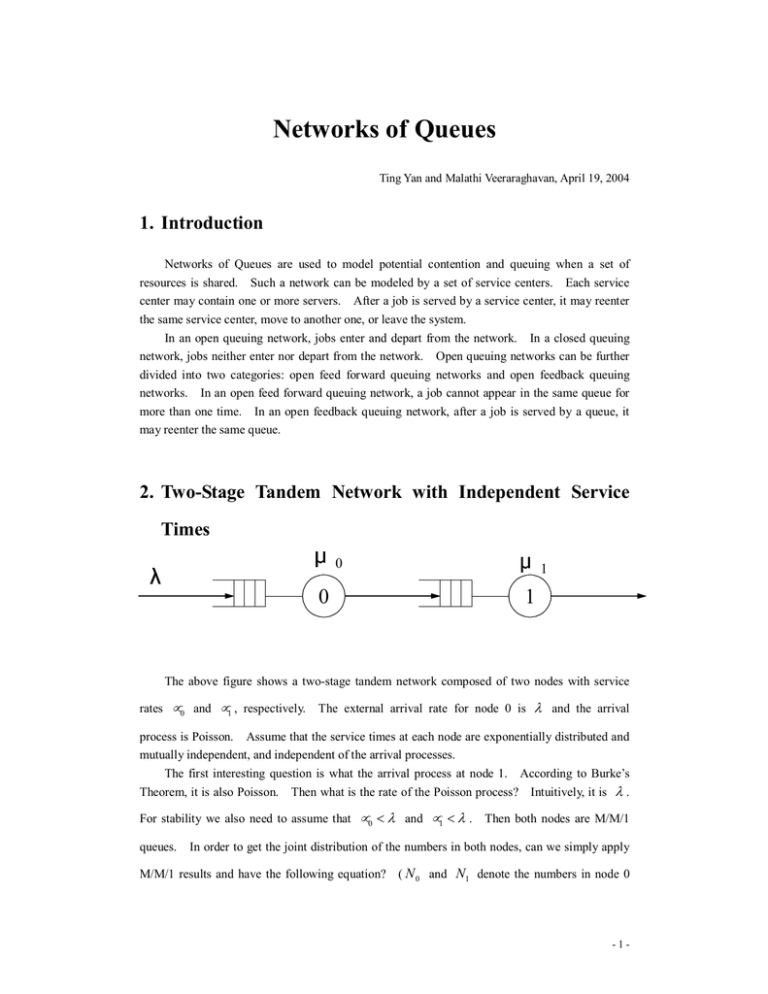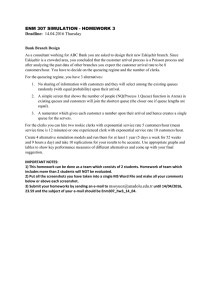Networks of Queues
advertisement

Networks of Queues
Ting Yan and Malathi Veeraraghavan, April 19, 2004
1. Introduction
Networks of Queues are used to model potential contention and queuing when a set of
resources is shared. Such a network can be modeled by a set of service centers. Each service
center may contain one or more servers. After a job is served by a service center, it may reenter
the same service center, move to another one, or leave the system.
In an open queuing network, jobs enter and depart from the network. In a closed queuing
network, jobs neither enter nor depart from the network. Open queuing networks can be further
divided into two categories: open feed forward queuing networks and open feedback queuing
networks. In an open feed forward queuing network, a job cannot appear in the same queue for
more than one time. In an open feedback queuing network, after a job is served by a queue, it
may reenter the same queue.
2. Two-Stage Tandem Network with Independent Service
Times
0
1
0
1
The above figure shows a two-stage tandem network composed of two nodes with service
rates µ0 and µ1 , respectively.
The external arrival rate for node 0 is λ and the arrival
process is Poisson. Assume that the service times at each node are exponentially distributed and
mutually independent, and independent of the arrival processes.
The first interesting question is what the arrival process at node 1. According to Burke’s
Theorem, it is also Poisson. Then what is the rate of the Poisson process? Intuitively, it is λ .
For stability we also need to assume that µ 0 < λ and µ1 < λ .
queues.
Then both nodes are M/M/1
In order to get the joint distribution of the numbers in both nodes, can we simply apply
M/M/1 results and have the following equation? ( N 0 and N1 denote the numbers in node 0
-1-
and node 1, respectively.
ρ 0 = µ0 / λ
ρ1 = µ1 / λ . )
p ( N 0 , N1 ) = (1 − ρ0 ) ρ0N 0 (1 − ρ1 ) ρ1N1
(2.1)
In order to get the above result, we need the assumption that N 0 and N1 are mutually
independent. Does it hold?
Burke’s Theorem says for M/M/1 queue at any time t , the number
in the system is independent of the sequence of departure times prior to t .
Therefore, N 0 is
independent of N1 . The proof of Burke’s Theorem is given in the appendix.
We can also analyze the state diagram for the stochastic process ( N 0 , N1 ) and derive
p ( N 0 , N1 ) in a similar way to the derivation of state probabilities for M/M/1 queue.
0,0
1,0
2,0
…
0
1
0
1
0,1
1,1
…
1
0
0
1
0,2
…
m,n
0
1
For the internal states, we have the following balance equations:
( µ0 + µ1 + λ ) p( N 0 , N1 ) = µ0 p( N 0 + 1, N1 − 1) + µ1 p( N 0 , N1 + 1) + λ p( N 0 − 1, N1 ),
N 0 > 0, N1 > 0.
(2.2)
For the boundary states, we have:
( µ0 + λ ) p ( N 0 , 0) = µ0 p ( N 0 − 1, 0) + µ1 p ( N 0 ,1), N 0 > 0,
(2.3)
( µ1 + λ ) p(0, N1 ) = µ0 p(1, N1 − 1) + µ1 p(0, N1 + 1), N1 > 0,
(2.4)
λ p(0, 0) = µ1 p(0,1).
(2.5)
After all, for normalization we have:
-2-
N0 ≥ 0 N1 ≥ 0
p ( N 0 , N1 ) = 1.
(2.6)
Solve these equations and we obtain the solution,
p ( N 0 , N1 ) = (1 − ρ0 ) ρ0N 0 (1 − ρ1 ) ρ1N1
(2.7)
which is exact the same as (2.1).
3. Two-Stage Tandem Network with Dependent Service
Times
0
1
0
1
Consider that the two nodes are transmission lines, where service time is proportional to the
packet length. We also assume that the packet lengths are Poisson and independent of the arrival
process. Does the above result still apply? The answer is no. The issue here is that the arrival
times for node 2 are strongly correlated with packets lengths, and therefore the service process.
The following figure shows why.
Long packet
Short packet
Arrival times at node 0
Long packet
Short packet
Arrival times at node 1,
or departure times at
node 0
transmission time of long packet
transmission time of short packet
From the above figure, we can also see that a long packet suffers less waiting time than a
short one does on average. The reason is that it takes longer for a long packet to be transmitted
in the first line, and therefore the second line gets more time to empty out.
There exists no analytical results for such networks in which interarrival and service times
are dependent. However, Kleinrock independence approximation states that “merging several
packet streams on a transmission line has an effect akin to restoring the independence of
interarrival times and packet lengths” [1] thus an M/M/1 model can be used to analyze the
behavior of each communication link.
When the arrival/service time correlation is eliminated and randomization is used to divide
the traffic, Jackson’s Theorem provides an analytical approach to derive the average numbers in
the system for a broad category of queuing networks.
-3-
4. Average Delay
Consider a network composed of nodes and links between nodes. Applying Kleinrock
independence approximation, each link can be modeled as an M/M/1 queue. Thus we have the
average number of packets in queue or service at link (i, j) is
N ij =
λij
µij − λij
(4.1)
After summing over all queues, we have
λij
N=
(i , j )
µij − λij
(4.2)
Apply Little’s Law and ignore processing and propagation delay, the average delay per
packet
T=
where
1
γ
λij
(i, j)
is the total arrival rate in the system.
µij − λij
(4.3)
If the delay d ij can not be ignored, the formula
should be modified to
T=
1
γ
λij
(
(i , j )
µij − λij
+ λij dij )
(4.4)
And the average delay per packet for a certain traffic stream traversing a path p is
Tp =
(
( i , j )∈ p
λij
1
+
+ d ij )
µij ( µij − λij ) µij
(4.5)
5. Jackson’s Theorem for Open Queuing Networks
Jackson’s Theorem provides a general product-form solution for both feed forward and
feedback open queuing networks.
The assumptions for Jackson’s Theorem are:
(1) the network is composed of K FCFS, single-server queues
(2) the arrival processes for the K queues are Poisson at rate r1, r2 , …, rK;
(3) the service times of customers at jth queue are exponentially distributed with mean 1/ j
and they are mutually independent and independent f the arrival processes;
(4) once a customer is served at queue i, it joins each queue j with probability Pij or leave the
system with probability 1 −
to node j.
K
j =1 ij
P.
Pij is called the routing probability from node i
For all possible i and j, Pij compose the routing matrix.
-4-
The following figure shows the general structure for open queuing networks.
Pii
ri
rj
i
i
i
Pij
Pji
j
j
j
Pjj
The following figure shows a virtual circuit network example.
x1
=x1+x2
i
x2
j
x3
Here is a feedback example.
0
p1
CPU
1
I/O
p0
And the following figure gives the internal state transitions.
-5-
N0+1, N1-1
p1
1
0
N0-1, N1
N0,N1
p0
N0+1, N1
p0
0
0
p1
1
0
N0-1, N1+1
In order to calculate the arrival rates at each queue, firstly we have the following equations:
λ j = rj +
K
i =1
λi Pij ,
j = 1,..., K
Solve the linear equations and λi are obtained.
(5.1)
Define utilization factor for each queue as
ρ j = λ j / µ j , j = 1,..., K .
Then we have:
Jackson’s Theorem.
Assuming that
ρ j < 1, j = 1,..., K , we have for all N1 ,..., N K ≥ 0 ,
P( N1 ,..., N K ) = P1 ( N1 ) P2 ( N 2 )...PK ( N K )
(5.2)
Pj ( N j ) = ρ j j (1 − ρ j ), N j ≥ 0
(5.3)
where
N
Then we have the average number in each queue:
E[ N j ] =
ρj
1− ρ j
(5.4)
We may applying Little’s Law and get the average response time. For example hen we have
only one external arrival with rate , we have the average response time formula
E[ R ] =
1
λ
(5.5)
E[ N j ]
j
For feed forward networks, the above result is straightforward. It’s trickier for feedback
networks. In feedback networks, the arrival process for a queue may not be Poisson. The
following is a simple example. Consider a queue in which r
µ , and after a customer is
served, it is sent back to the same queue with a probability p which is very close to 1. Given
there is an arrival, it is very likely that there will be an arrival soon because the customer will be
sent back again with a high probability. But when there is no customer in the system, because r
-6-
is very small, it is very unlikely that there will be an arrival soon. Evidently the arrival process is
not memoryless. So the total arrival process may not be Poisson thus the queue is not M/M/1.
Nevertheless, Jackson’s Theorem still holds even when the total arrival process at each queue is
not Poisson.
Jackson’s Theorem can also be extended to even more general scenarios, for example M/M/m
queues. We can generalize M/M/m or M/M/ to allow the service rate at each queue to depend
on the number of customers at that queue. Suppose the service time at the jth queue is
exponentially distributed with rate µ j ( m ) , where m is the number in the queue just before the
customer’s departure.
We define
ρ j (m) = λ j / µ j (m), j = 1,..., K , m = 1, 2,...
(5.6)
and
Nj = 0
Pˆj ( N j ) =
1,
ρ j (1) ρ j (2)...ρ j ( N j ) N j > 0
(5.7)
We have:
Jackson’s Theorem for State-Dependent Service Rates.
P( N1 ,..., N ) =
We have for all N1 ,..., N K ≥ 0 ,
Pˆ1 ( N1 )...PˆK ( N K )
G
(5.8)
assuming 0 < G < ∞ , where G is the normalization factor:
G=
∞
∞
...
N1 = 0
NK =0
Pˆ1 ( N1 )...PˆK ( N K )
(5.9)
4. Closed Queuing Networks
Closed queuing networks model a system in which multiple resources are shared and no job
enters or departs. It can also approximate a system involving multiple resource holding under
heavy load. Although jobs enter and depart from these systems, under heavy load, once a job
leaves the system, an already waiting job will be put in immediately so that a constant degree of
multiprogramming M is maintained.
Pii
i
i
i
Pij
Pji
j
j
j
-7-
Pjj
For closed queuing networks, we need to modify the system requirement by
K
j =1
Pij = 1,
i = 1,..., K
(6.1)
λi Pij
(6.2)
and
λj =
K
i =1
Note that there is no external arrival entering the system.
can be solved with the form
λ j ( M ) = α ( M )λ j ,
Under certain conditions, (6.2)
j = 1,..., K
(6.3)
Denote
ρ j (m ) =
λj
(6.4)
µ j ( m)
Nj = 0
Pˆj ( N j ) =
1,
ρ j (1) ρ j (2)...ρ j ( N j ) N j > 0
(6.5)
and
G (M ) =
{( N1 ,..., N K )| N1 +...+ N K = M }
Pˆ1 ( N1 )...PˆK ( N K )
(6.6)
We have:
Jackson’s Theorem for Closed Networks:
We have for all N1 ,..., N K ≥ 0 , and
N1 + ... + N K = M ,
P( N1 ,..., N K ) =
Pˆ1 ( N1 )...PˆK ( N K )
G(M )
(6.7)
How many states does the system have? Or, how many nonnegative integer solutions are
there for the equation N1 + ... + N K = M ? A little counting theory gives the result
M + K −1
Number of system states=
M
(6.8)
This number increases exponentially with M and K , it is very difficult to calculate
G ( M ) with (6.6). Simple algorithms have been developed to make this mission possible.
If each node of the system is a single queue, then ρ j ( m) = ρ j for any m .
(6.6)
becomes
G (M ) =
ρ1N ...ρ KN
1
{( N1 ,..., N K )| N1 +...+ N K = M }
K
(6.9)
-8-
From (6.9), define a polynomial in z
K
Γ( z) = ∏
i =1
1
1 − ρi z
= (1 + ρ1 z + ρ12 z 2 + ...)(1 + ρ 2 z + ρ22 z 2 + ...)...
(6.10)
(1 + ρ K z + ρ K2 z 2 + ...)
This is the generating function of G(1) , G (2) , …
∞
Γ( z) =
G ( n) z n
(6.11)
n =0
where G(0)=1.
Define
i
Γi ( z ) = ∏
j =0
1
,
j = 1,..., K
(6.12)
Gi ( j ) z j ,
i = 1,..., K
(6.13)
1− ρ j z
and
Γi ( z ) =
∞
j=0
where GK ( j ) = G ( j ) .
We will be able to get the recursive formula to compute GK ( j ) :
Gi ( j ) = Gi −1 ( j ) + ρiGi ,
i = 2,3,..., K
j = 1, 2,..., M
(6.14)
with the initial values G1 ( j ) = ρ1 , j = 1, 2,..., M and Gi (0) = 1 , i = 1, 2,..., K .
j
This algorithm is efficient both in time and space.
Another approach is called Mean Value Analysis, in which the average number of customers
and average customer time spent per visit in each queue are directly calculated. Assume the
service rate does not depend on states. First, when M = 0 , we have trivially
T j (0) = N j (0) = 0,
.
j = 1,..., K
(6.15)
Then the Arrival Theorem is applied to get the recursive formula for T j ( s ) :
T j ( s) =
1
µj
(1 + N j (s − 1)),
j = 1,..., K
s = 1,..., M
(6.16)
Finally Little’s Law is applied to get N j ( s ) :
-9-
λ jTj ( s)
N j ( s) = s
K
i =1
,
λ jTj ( s)
j = 1,..., K
s = 1,..., M
(6.17)
The Arrival Theorem states that in a closed product-form queuing network, the probability
mass function of the number of jobs seen at the time of arrival to node i when there are n jobs
in the network is equal to that of the number of jobs at the node with one less job in the network.
Appendix – Burke’s Theorem and Reversibility
Burke’s Theorem: In steady-state of an M/M/1, M/M/m, or M/M/ queue, the following
hold true:
(a) The departure process is Poisson with the arrival rate λ .
(b) At each time t , the number of customers in the system is independent of the sequence of
departure times prior to t .
To prove Burke’s Theorem, we need to have some idea on reversibility.
Consider an irreducible and aperiodic DTMC X n , X n +1 , … with transition probability Pij
and stationary distribution
{p
j
| j ≥ 0} with p j > 0 for all j that is in steady-state, that is,
P { X n = j} = p j , for all n
(0.1)
Consider the sequence of states going backward in time X n , X n−1 , … .
It can be proved
that this sequence is also a Markov chain (how?) and
Pij* = P{ X m = j | X m+1 = i}
=
(0.2)
p j Pji
pi
We say that the Markov chain is time reversible if Pij = Pij for all i, j.
*
It can be easily seen
that the reversed chain is also irreducible, aperiodic, and has the same stationary distribution as the
forward chain.
If we can find positive numbers pi , i ≥ 0 ,
∞
j =0
then
{ pi | i ≥ 0}
Pij* =
∞
p j Pji
j =0
pi
∞
i =0
pi = 1 and
= 1,
i = 0,1,...
(0.3)
*
is the stationary distribution and Pij are the transition probabilities of the
reversed chain. (Prove it with the global balance equation) A variation for CTMC is used to
prove Jackson’s Theorem by first guessing and proving the transition rates, and then proving the
- 10 -
stationary distribution as the form given in the theorem satisfies
∞
j =0
qij =
∞
p j q ji
j=0
pi
, for all i, j ≥ 0
(0.4)
A chain is time reversible if and only if the detailed balance equation (directly from
definition)
pi Pij = p j Pji , i, j ≥ 0
(0.5)
We know that any birth-death processes are time reversible. So the queuing systems such as
M/M/1, M/M/m, M/M/m/m, etc. are all time reversible.
For CTMC, the analysis and properties are analogous and the only difference is that
transition rates are used instead of transition probabilities.
For a queuing system, which is time reversible, we may represent the reverse process by
another queuing system in which departures correspond to arrivals of the original system and
arrivals to departures in the original system. In steady-state, the forward and reversed systems
are statistically indistinguishable, which gives part (a) of Burke’s Theorem. At each time t , the
sequence of departure times prior to t correspond to the arrival times after t in the reversed
system. Since arrivals are Poisson, these future arrivals do not depend on or affect the number in
the system. Therefore we have part (b) of Burke’s Theorem.
This lecture note is taken from [1] mostly, sometimes verbatim.
included.
Some materials in [2] are also
References
[1] D. Bertsekas and R. Gallager, “Data Networks,” Prentice Hall, 1986, ISBN 0-13-196825-4.
[2] K. S. Trivedi, “Probability, Statistics with Reliability, Queueing and Computer Science
Applications,” Second Edition, Wiley, 2002, ISBN 0-471-33341-7.
- 11 -



